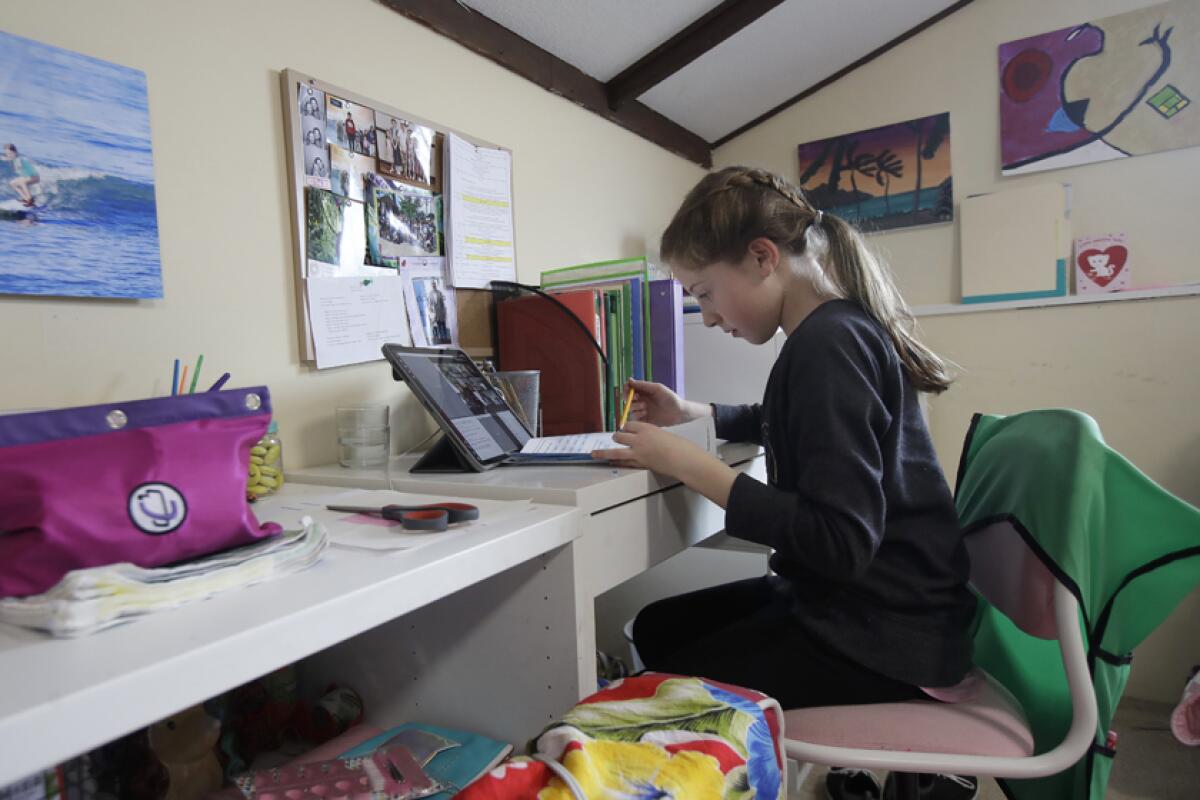Op-Ed: Why remote learning is hard — and how to make it easier

- Share via
We knew in March that students wouldn’t learn much during lockdown, and they seem to be in for more of the same this fall. The problem isn’t just that teachers lack experience with remote instruction. For reasons scientists only partially understand, it’s demonstrably harder to learn via video than in person. Education Secretary Betsy DeVos and the rest of the Trump administration maintain that because online learning is hard, healthy kids should be in school. But research points to another solution to the video learning problem.
The problem is dramatic in children younger than 4. In a typical experiment, a researcher is filmed using a new word or describing the location of a hidden object. A child who sees the experimenter live is more likely to learn than one who watches the video. One explanation for this phenomenon is that videos lack the social cues face-to-face interactions provide.
Older children don’t show a learning deficit, implying that they’re somehow compensating for what the video lacks. But they can’t maintain the necessary attentional focus for an entire Zoom class, so learning suffers. That interpretation sits well with adults’ experience of Zoom fatigue: We get through our meetings, but making up for the absent social cues drains us. How might teachers help?
Forcing distance learning to look like ‘normal’ school will hurt our youngest students. Here are strategies were effective when COVID shut down traditional classrooms.
Different learning tasks capitalize on different social cues. We can make some reasonable guesses about when video makes learning difficult.
A class discussion requires conversational turn-taking, and eye movements play a central role. For example, if you are speaking and I break eye contact, that indicates I want a conversational turn. If I’m speaking, a prolonged gaze signals an intention to yield the floor.
These signals are lost in videoconferencing, both because internet lag disrupts their timing and because computer equipment makes eye contact difficult. I see your eyes when I look at my screen, but you see my eyes when I look at my camera. The disconnect is part of why Zoom meetings brim with interruptions and awkward pauses.
During lectures, eye contact matters less than gesture. Instructors support explanations with their hands, as when a math teacher unconsciously mimes a pan balance scale to explain equivalence. Gestures aid student comprehension, but they’re usually absent from videoconferencing. Teachers sit near the computer to control their keyboard and mouse, which means students see only their faces.
Many lectures require demonstrations, with the instructor and student directing attention to a graph or an online laboratory simulation. During these tasks a teacher tends to use another type of gesture: She’ll point, or as she gives the instruction “turn it,” she’ll gesture to show which way. Unlike the balance example, these gestures require having the other person’s perspective on the object. Researchers have found it challenging to give users this sense of shared space during videoconferencing.
Overcoming these obstacles is usually possible. If I can’t point with my finger, I’ll “point” verbally: If I want students to look at a large, blue section of a graph, I can say, “Look at the big blue section.” Devising such workarounds is trivial in a two-minute Zoom call. But the costs accumulate over hours of video expounding difficult academic content.
That’s one reason 80% of adults who start non-credit online courses fail to complete them. And it’s a reason a lot of students simply didn’t show up for remote lessons last spring.
So now what?
We can guess at some fixes. For example, instead of sitting at a desktop while lecturing, a teacher might stand and step back from the camera so that gestures are viewable. But researchers don’t know enough to guarantee solid learning improvements. The summer, which the federal government might have used to organize a “Warp Speed” effort to find solutions, has instead passed in a narcotic dream that fall would bring students back to school — the vision Secretary DeVos still hopes will triumph.
But there’s another way. Research shows remote learning is more successful if a facilitator (usually a parent) is present. Companies that provide online education to home schoolers routinely stipulate that an adult supervise an elementary or middle school student.
That’s not a luxury. With our current technology and understanding, it’s a prerequisite to a successful remote learning program. And it shouldn’t be available only to the learning-pod wealthy. The federal government could, through grants to states, provide funds to hire parents to serve as learning facilitators for small groups of children in grades K through 8. A similar emergency pandemic measure through Medicaid has allowed parents to be paid as caregivers for their disabled children.
The hallmark of an educated mind is learning from experience. Shame on us if we condemn our children to repeat last spring.
Daniel T. Willingham is a professor in the department of psychology at the University of Virginia.
More to Read
A cure for the common opinion
Get thought-provoking perspectives with our weekly newsletter.
You may occasionally receive promotional content from the Los Angeles Times.










